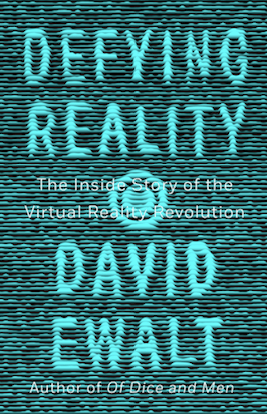Melvin the Barbarian is angry at the dirty goblin sniping arrows at him from behind a tree. I can hear it in his voice; my earphones convey every nuance of his bellowed threats, even if the avatar I see in my headset remains passive, resembling less a raging half-Orc than a featureless robot. I can’t see when he swings his greataxe, but I know the attack connects. The little blue die Melvin tosses across our virtual play area comes up 20, and that means the goblin has fired his last shot.
The fantasy role-playing game Dungeons & Dragons (D&D) is usually played with pencils and paper, around a table, with no gadgetry involved. But recent innovations in the field of virtual reality allow characters like Melvin to team up with other players inside high-tech simulated worlds. I don’t know the real name of the person playing this raging barbarian, or his physical location, or anything about him other than the sound of his voice. But here we are, slaying monsters together inside an online game space constructed by a company called AltspaceVR. We haven’t really met, but I think I’ve made a new friend.
In the 44-year history of D&D, emerging technologies have usually been the game’s foe. When home video game consoles became popular in the mid-1980s, the hobby lost millions of players; in the ‘90s, online role-playing games (RPGs) like Everquest and World of Warcraft took away even more. But it turns out that 21st-century technologies that create immersive, simulated environments are complementary to tabletop gaming’s social vibe. Virtual reality could be the best thing to happen to D&D since polyhedral dice.
Until now, players have struggled to replicate the tabletop gaming experience using the tools of the digital age. In the ‘80s, I tried to play a few times with my friends all dialed into a telephone party line, but it was too noisy and chaotic. In more recent years, I’ve been in one or two games played successfully over Skype or Google Hangouts, which allow you to see your friends’ faces. And a few specialized bits of software like the website Roll20 and the application Fantasy Grounds combine video conferencing with shared maps and dice-rolling tools. If you can’t meet in person, they’re good enough for a few hours of fun.
But I’d never been excited about playing D&D over a computer until a new generation of virtual reality hardware, like the Oculus Rift and HTC Vive, met the social VR spaces created by companies like AltspaceVR. In 2015, D&D publisher Wizards of the Coast cut a deal with Altspace (then a startup, now a subsidiary of Microsoft) to bring officially licensed D&D assets to a tavern-themed virtual game room. Users put on their VR headsets, gather around a 3D table and appear as individual avatars inside the space. They can build a map using dungeon, wilderness and city themed terrain tiles; record their characters on official D&D character sheets; and move around figurines representing various D&D player classes as well as monsters (including gelatinous cubes and dragons).
VR may be the ultimate “you have to see it to believe it” experience. But as a one-time skeptic of the technology, I can testify that I was surprised how much Altspace’s virtual game room felt like the real thing. When you’re immersed in these simulated worlds, you forget where you are; the table in front of you seems solid, the people around you move and everyone seems to be gathered in the same room.
Sure, the virtual version of D&D is far from perfect. While today’s VR hardware can create surprisingly convincing simulations, it’s no fun wearing a VR headset for more than an hour. The graphics are still relatively primitive—more Lawnmower Man than The Matrix—and your fellow players are represented by cartoonish avatars, not realistic depictions of their actual selves. But VR is good enough in 2018 to provide proof of concept; it actually feels like D&D. The problems are just technical hurdles, and we’ll clear them in time.
In five years, I suspect playing D&D in virtual reality will be almost as good as playing around a dining room table. Next generation headsets will be lighter and more comfortable; graphics will get to a point comparable to the most realistic 3D video games. Tracking technologies will allow you to see where players are looking, make eye contact and read expressions on their faces. Our digital selves will convey body language and gestures, making it feel like you’re in the same place as your friends.
And the virtual tabletops will be even better than the real thing. When you’re playing D&D on a friend’s dining room table, the game is limited by physical accessories like dry-erase battle maps, pre-printed terrain tiles and miniatures to represent characters. In a virtual world, those elements can come alive. Animated, photo-realistic maps can slowly reveal themselves as players advance through a dungeon, and their minis can actually move and fight. Imagine the Millennium Falcon’s holographic chess game, but more realistic than any animation Industrial Light and Magic could pull off.
But the best thing about D&D in VR isn’t the bells and whistles—it’s how it will bring people together. For decades, too many RPG campaigns have been crippled by the limitations of geography; all too often, it’s impossible to get enough players together in one place. With VR, it doesn’t matter if your Dungeon Master moves to Timbuktu. VR will let you step into a game room and play with people around the world.
And when it comes to D&D, the gathering is more important than the game itself.
Article plucked from: https://www.pastemagazine.com/articles/2018/08/why-virtual-reality-is-the-future-of-dungeons-drag.html


Be the first to comment on "Why Virtual Reality Is the Future of Dungeons & Dragons"